Tourism Fieldwork Report: Creativity in the Tourism Sector
VerifiedAdded on 2023/01/11
|15
|5102
|66
Report
AI Summary
This report delves into the critical role of creativity within the tourism sector, emphasizing its impact on attracting tourists and shaping destination identities. It begins with an introduction highlighting the significance of creativity in modern tourism, followed by a literature review that explores various definitions and perspectives on creative tourism. The main body of the report includes a case study focusing on Manchester, a city known for its creative environment, and a section on creative tourist trails. The literature review examines the changing trends in tourism, the importance of creative attractions, and the advantages of creative tourism, such as diversification and the creation of unique experiences. The report also discusses the different forms of creativity in tourism, including creative events and places, and their impact on tourism destinations. The report concludes by summarizing the key findings and emphasizing the importance of creativity for the future of the tourism industry.

TLH214 Tourism Fieldwork
Paraphrase This Document
Need a fresh take? Get an instant paraphrase of this document with our AI Paraphraser

TABLE OF CONTENTS
INTRODUCTION...........................................................................................................................3
MAIN BODY..................................................................................................................................3
Literature Review........................................................................................................................3
Context/Case Study.....................................................................................................................8
Creative Tourist Trail................................................................................................................10
CONCLUSION..............................................................................................................................12
REFERENCES..............................................................................................................................13
INTRODUCTION...........................................................................................................................3
MAIN BODY..................................................................................................................................3
Literature Review........................................................................................................................3
Context/Case Study.....................................................................................................................8
Creative Tourist Trail................................................................................................................10
CONCLUSION..............................................................................................................................12
REFERENCES..............................................................................................................................13
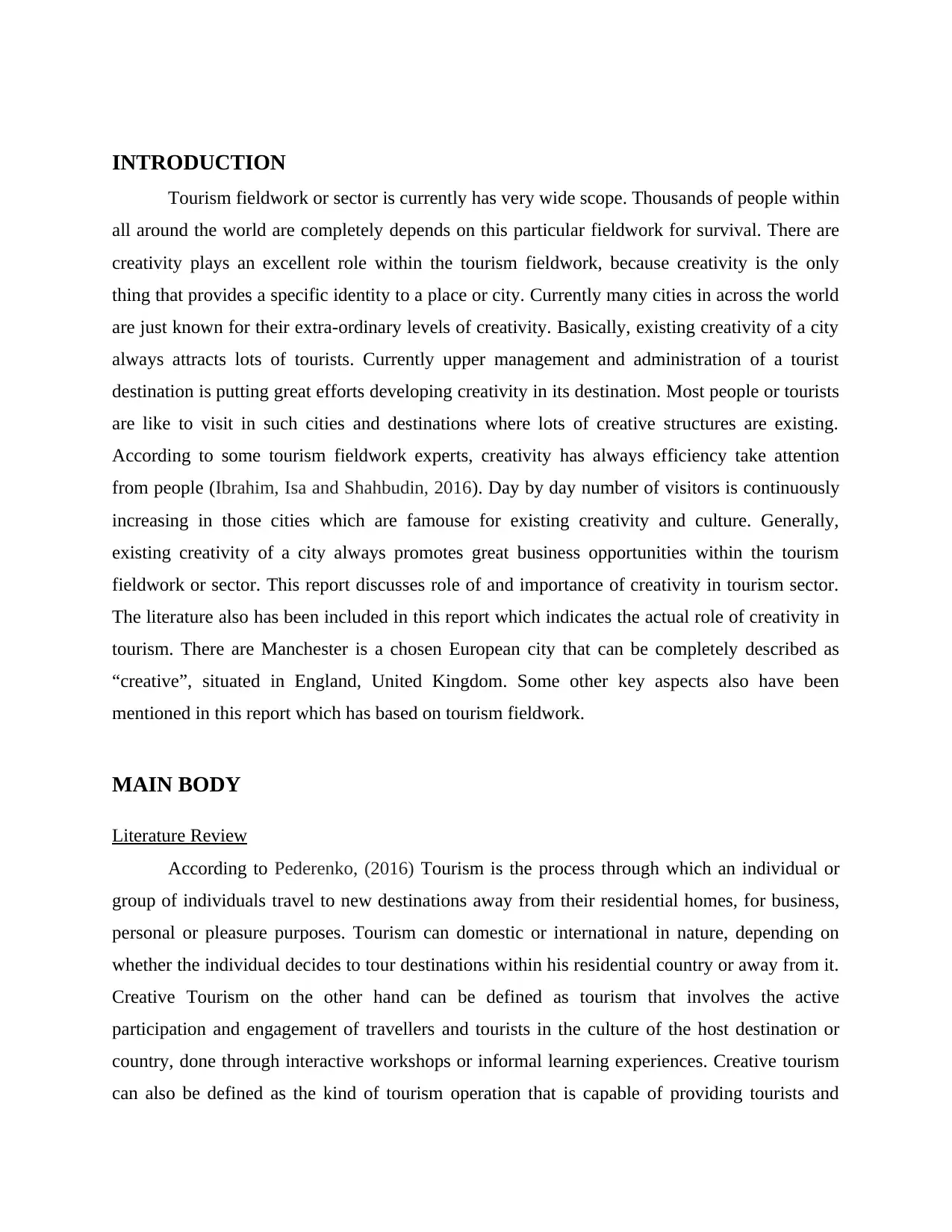
INTRODUCTION
Tourism fieldwork or sector is currently has very wide scope. Thousands of people within
all around the world are completely depends on this particular fieldwork for survival. There are
creativity plays an excellent role within the tourism fieldwork, because creativity is the only
thing that provides a specific identity to a place or city. Currently many cities in across the world
are just known for their extra-ordinary levels of creativity. Basically, existing creativity of a city
always attracts lots of tourists. Currently upper management and administration of a tourist
destination is putting great efforts developing creativity in its destination. Most people or tourists
are like to visit in such cities and destinations where lots of creative structures are existing.
According to some tourism fieldwork experts, creativity has always efficiency take attention
from people (Ibrahim, Isa and Shahbudin, 2016). Day by day number of visitors is continuously
increasing in those cities which are famouse for existing creativity and culture. Generally,
existing creativity of a city always promotes great business opportunities within the tourism
fieldwork or sector. This report discusses role of and importance of creativity in tourism sector.
The literature also has been included in this report which indicates the actual role of creativity in
tourism. There are Manchester is a chosen European city that can be completely described as
“creative”, situated in England, United Kingdom. Some other key aspects also have been
mentioned in this report which has based on tourism fieldwork.
MAIN BODY
Literature Review
According to Pederenko, (2016) Tourism is the process through which an individual or
group of individuals travel to new destinations away from their residential homes, for business,
personal or pleasure purposes. Tourism can domestic or international in nature, depending on
whether the individual decides to tour destinations within his residential country or away from it.
Creative Tourism on the other hand can be defined as tourism that involves the active
participation and engagement of travellers and tourists in the culture of the host destination or
country, done through interactive workshops or informal learning experiences. Creative tourism
can also be defined as the kind of tourism operation that is capable of providing tourists and
Tourism fieldwork or sector is currently has very wide scope. Thousands of people within
all around the world are completely depends on this particular fieldwork for survival. There are
creativity plays an excellent role within the tourism fieldwork, because creativity is the only
thing that provides a specific identity to a place or city. Currently many cities in across the world
are just known for their extra-ordinary levels of creativity. Basically, existing creativity of a city
always attracts lots of tourists. Currently upper management and administration of a tourist
destination is putting great efforts developing creativity in its destination. Most people or tourists
are like to visit in such cities and destinations where lots of creative structures are existing.
According to some tourism fieldwork experts, creativity has always efficiency take attention
from people (Ibrahim, Isa and Shahbudin, 2016). Day by day number of visitors is continuously
increasing in those cities which are famouse for existing creativity and culture. Generally,
existing creativity of a city always promotes great business opportunities within the tourism
fieldwork or sector. This report discusses role of and importance of creativity in tourism sector.
The literature also has been included in this report which indicates the actual role of creativity in
tourism. There are Manchester is a chosen European city that can be completely described as
“creative”, situated in England, United Kingdom. Some other key aspects also have been
mentioned in this report which has based on tourism fieldwork.
MAIN BODY
Literature Review
According to Pederenko, (2016) Tourism is the process through which an individual or
group of individuals travel to new destinations away from their residential homes, for business,
personal or pleasure purposes. Tourism can domestic or international in nature, depending on
whether the individual decides to tour destinations within his residential country or away from it.
Creative Tourism on the other hand can be defined as tourism that involves the active
participation and engagement of travellers and tourists in the culture of the host destination or
country, done through interactive workshops or informal learning experiences. Creative tourism
can also be defined as the kind of tourism operation that is capable of providing tourists and
⊘ This is a preview!⊘
Do you want full access?
Subscribe today to unlock all pages.

Trusted by 1+ million students worldwide
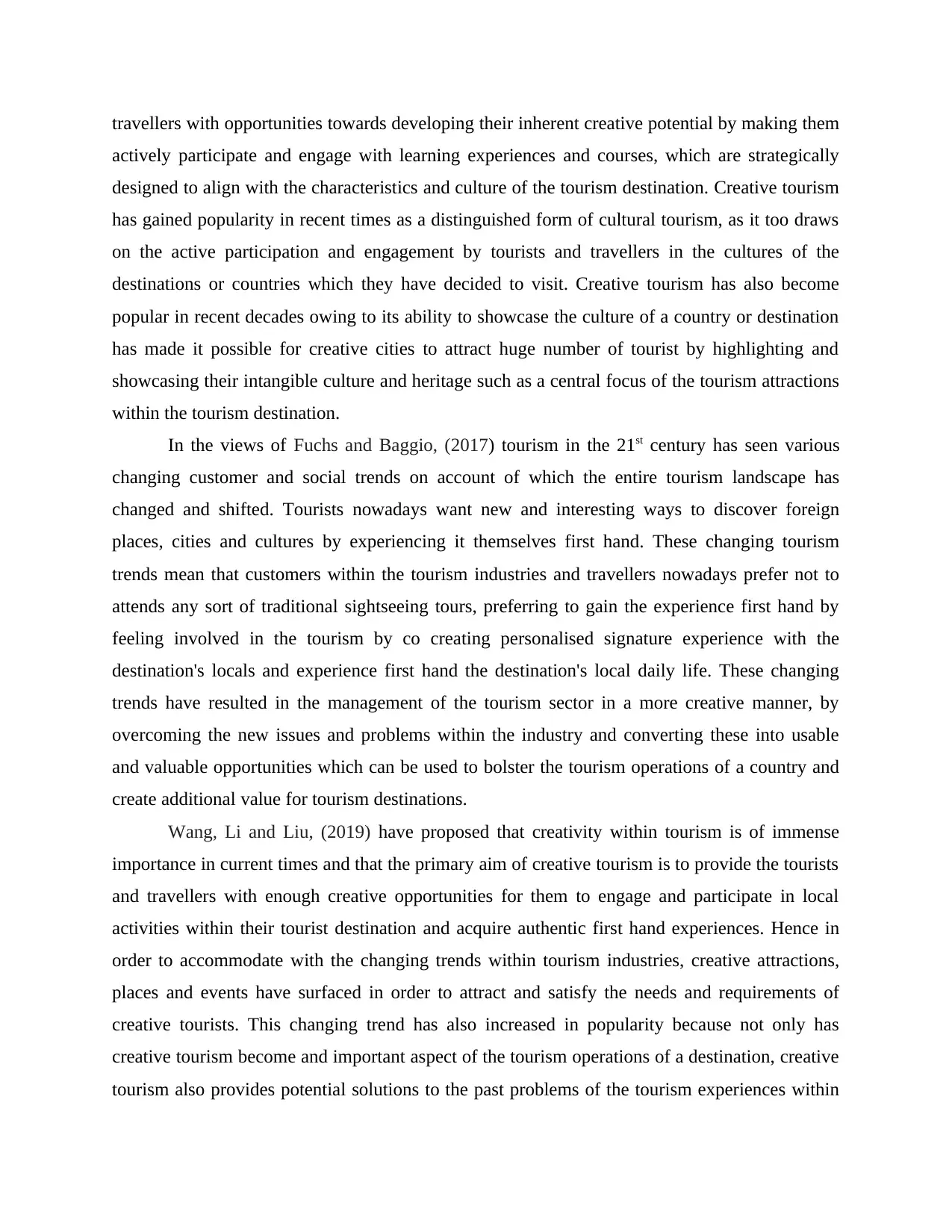
travellers with opportunities towards developing their inherent creative potential by making them
actively participate and engage with learning experiences and courses, which are strategically
designed to align with the characteristics and culture of the tourism destination. Creative tourism
has gained popularity in recent times as a distinguished form of cultural tourism, as it too draws
on the active participation and engagement by tourists and travellers in the cultures of the
destinations or countries which they have decided to visit. Creative tourism has also become
popular in recent decades owing to its ability to showcase the culture of a country or destination
has made it possible for creative cities to attract huge number of tourist by highlighting and
showcasing their intangible culture and heritage such as a central focus of the tourism attractions
within the tourism destination.
In the views of Fuchs and Baggio, (2017) tourism in the 21st century has seen various
changing customer and social trends on account of which the entire tourism landscape has
changed and shifted. Tourists nowadays want new and interesting ways to discover foreign
places, cities and cultures by experiencing it themselves first hand. These changing tourism
trends mean that customers within the tourism industries and travellers nowadays prefer not to
attends any sort of traditional sightseeing tours, preferring to gain the experience first hand by
feeling involved in the tourism by co creating personalised signature experience with the
destination's locals and experience first hand the destination's local daily life. These changing
trends have resulted in the management of the tourism sector in a more creative manner, by
overcoming the new issues and problems within the industry and converting these into usable
and valuable opportunities which can be used to bolster the tourism operations of a country and
create additional value for tourism destinations.
Wang, Li and Liu, (2019) have proposed that creativity within tourism is of immense
importance in current times and that the primary aim of creative tourism is to provide the tourists
and travellers with enough creative opportunities for them to engage and participate in local
activities within their tourist destination and acquire authentic first hand experiences. Hence in
order to accommodate with the changing trends within tourism industries, creative attractions,
places and events have surfaced in order to attract and satisfy the needs and requirements of
creative tourists. This changing trend has also increased in popularity because not only has
creative tourism become and important aspect of the tourism operations of a destination, creative
tourism also provides potential solutions to the past problems of the tourism experiences within
actively participate and engage with learning experiences and courses, which are strategically
designed to align with the characteristics and culture of the tourism destination. Creative tourism
has gained popularity in recent times as a distinguished form of cultural tourism, as it too draws
on the active participation and engagement by tourists and travellers in the cultures of the
destinations or countries which they have decided to visit. Creative tourism has also become
popular in recent decades owing to its ability to showcase the culture of a country or destination
has made it possible for creative cities to attract huge number of tourist by highlighting and
showcasing their intangible culture and heritage such as a central focus of the tourism attractions
within the tourism destination.
In the views of Fuchs and Baggio, (2017) tourism in the 21st century has seen various
changing customer and social trends on account of which the entire tourism landscape has
changed and shifted. Tourists nowadays want new and interesting ways to discover foreign
places, cities and cultures by experiencing it themselves first hand. These changing tourism
trends mean that customers within the tourism industries and travellers nowadays prefer not to
attends any sort of traditional sightseeing tours, preferring to gain the experience first hand by
feeling involved in the tourism by co creating personalised signature experience with the
destination's locals and experience first hand the destination's local daily life. These changing
trends have resulted in the management of the tourism sector in a more creative manner, by
overcoming the new issues and problems within the industry and converting these into usable
and valuable opportunities which can be used to bolster the tourism operations of a country and
create additional value for tourism destinations.
Wang, Li and Liu, (2019) have proposed that creativity within tourism is of immense
importance in current times and that the primary aim of creative tourism is to provide the tourists
and travellers with enough creative opportunities for them to engage and participate in local
activities within their tourist destination and acquire authentic first hand experiences. Hence in
order to accommodate with the changing trends within tourism industries, creative attractions,
places and events have surfaced in order to attract and satisfy the needs and requirements of
creative tourists. This changing trend has also increased in popularity because not only has
creative tourism become and important aspect of the tourism operations of a destination, creative
tourism also provides potential solutions to the past problems of the tourism experiences within
Paraphrase This Document
Need a fresh take? Get an instant paraphrase of this document with our AI Paraphraser
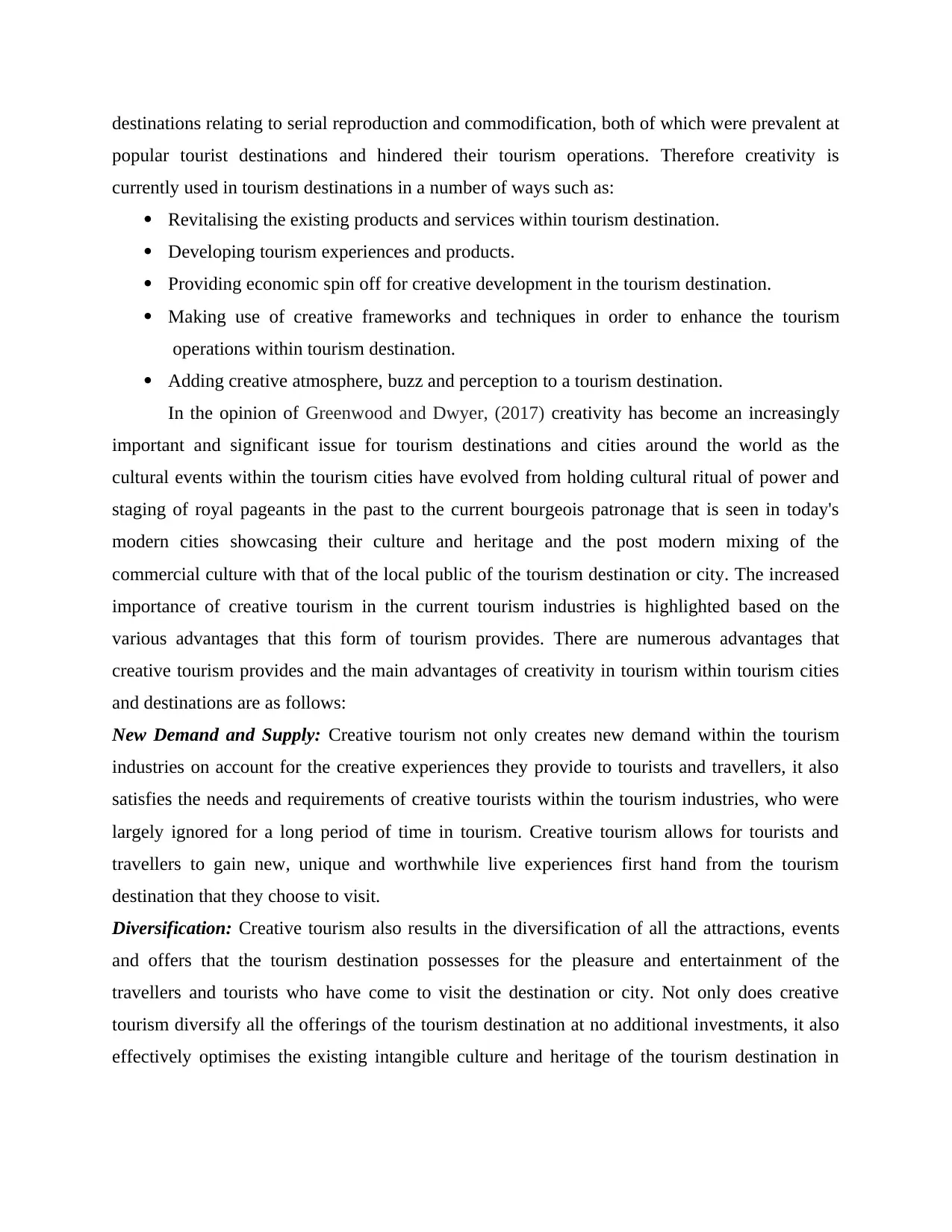
destinations relating to serial reproduction and commodification, both of which were prevalent at
popular tourist destinations and hindered their tourism operations. Therefore creativity is
currently used in tourism destinations in a number of ways such as:
Revitalising the existing products and services within tourism destination.
Developing tourism experiences and products.
Providing economic spin off for creative development in the tourism destination.
Making use of creative frameworks and techniques in order to enhance the tourism
operations within tourism destination.
Adding creative atmosphere, buzz and perception to a tourism destination.
In the opinion of Greenwood and Dwyer, (2017) creativity has become an increasingly
important and significant issue for tourism destinations and cities around the world as the
cultural events within the tourism cities have evolved from holding cultural ritual of power and
staging of royal pageants in the past to the current bourgeois patronage that is seen in today's
modern cities showcasing their culture and heritage and the post modern mixing of the
commercial culture with that of the local public of the tourism destination or city. The increased
importance of creative tourism in the current tourism industries is highlighted based on the
various advantages that this form of tourism provides. There are numerous advantages that
creative tourism provides and the main advantages of creativity in tourism within tourism cities
and destinations are as follows:
New Demand and Supply: Creative tourism not only creates new demand within the tourism
industries on account for the creative experiences they provide to tourists and travellers, it also
satisfies the needs and requirements of creative tourists within the tourism industries, who were
largely ignored for a long period of time in tourism. Creative tourism allows for tourists and
travellers to gain new, unique and worthwhile live experiences first hand from the tourism
destination that they choose to visit.
Diversification: Creative tourism also results in the diversification of all the attractions, events
and offers that the tourism destination possesses for the pleasure and entertainment of the
travellers and tourists who have come to visit the destination or city. Not only does creative
tourism diversify all the offerings of the tourism destination at no additional investments, it also
effectively optimises the existing intangible culture and heritage of the tourism destination in
popular tourist destinations and hindered their tourism operations. Therefore creativity is
currently used in tourism destinations in a number of ways such as:
Revitalising the existing products and services within tourism destination.
Developing tourism experiences and products.
Providing economic spin off for creative development in the tourism destination.
Making use of creative frameworks and techniques in order to enhance the tourism
operations within tourism destination.
Adding creative atmosphere, buzz and perception to a tourism destination.
In the opinion of Greenwood and Dwyer, (2017) creativity has become an increasingly
important and significant issue for tourism destinations and cities around the world as the
cultural events within the tourism cities have evolved from holding cultural ritual of power and
staging of royal pageants in the past to the current bourgeois patronage that is seen in today's
modern cities showcasing their culture and heritage and the post modern mixing of the
commercial culture with that of the local public of the tourism destination or city. The increased
importance of creative tourism in the current tourism industries is highlighted based on the
various advantages that this form of tourism provides. There are numerous advantages that
creative tourism provides and the main advantages of creativity in tourism within tourism cities
and destinations are as follows:
New Demand and Supply: Creative tourism not only creates new demand within the tourism
industries on account for the creative experiences they provide to tourists and travellers, it also
satisfies the needs and requirements of creative tourists within the tourism industries, who were
largely ignored for a long period of time in tourism. Creative tourism allows for tourists and
travellers to gain new, unique and worthwhile live experiences first hand from the tourism
destination that they choose to visit.
Diversification: Creative tourism also results in the diversification of all the attractions, events
and offers that the tourism destination possesses for the pleasure and entertainment of the
travellers and tourists who have come to visit the destination or city. Not only does creative
tourism diversify all the offerings of the tourism destination at no additional investments, it also
effectively optimises the existing intangible culture and heritage of the tourism destination in
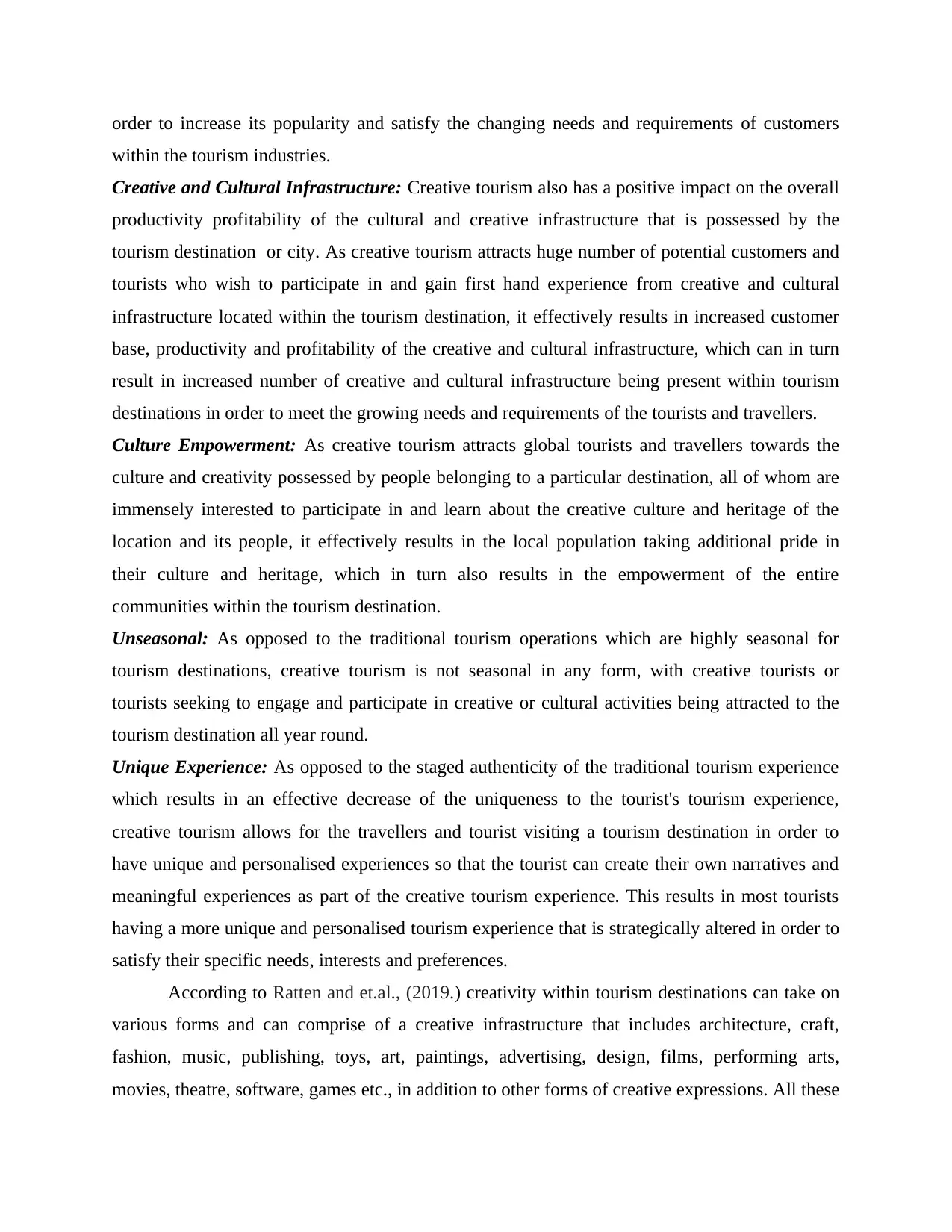
order to increase its popularity and satisfy the changing needs and requirements of customers
within the tourism industries.
Creative and Cultural Infrastructure: Creative tourism also has a positive impact on the overall
productivity profitability of the cultural and creative infrastructure that is possessed by the
tourism destination or city. As creative tourism attracts huge number of potential customers and
tourists who wish to participate in and gain first hand experience from creative and cultural
infrastructure located within the tourism destination, it effectively results in increased customer
base, productivity and profitability of the creative and cultural infrastructure, which can in turn
result in increased number of creative and cultural infrastructure being present within tourism
destinations in order to meet the growing needs and requirements of the tourists and travellers.
Culture Empowerment: As creative tourism attracts global tourists and travellers towards the
culture and creativity possessed by people belonging to a particular destination, all of whom are
immensely interested to participate in and learn about the creative culture and heritage of the
location and its people, it effectively results in the local population taking additional pride in
their culture and heritage, which in turn also results in the empowerment of the entire
communities within the tourism destination.
Unseasonal: As opposed to the traditional tourism operations which are highly seasonal for
tourism destinations, creative tourism is not seasonal in any form, with creative tourists or
tourists seeking to engage and participate in creative or cultural activities being attracted to the
tourism destination all year round.
Unique Experience: As opposed to the staged authenticity of the traditional tourism experience
which results in an effective decrease of the uniqueness to the tourist's tourism experience,
creative tourism allows for the travellers and tourist visiting a tourism destination in order to
have unique and personalised experiences so that the tourist can create their own narratives and
meaningful experiences as part of the creative tourism experience. This results in most tourists
having a more unique and personalised tourism experience that is strategically altered in order to
satisfy their specific needs, interests and preferences.
According to Ratten and et.al., (2019.) creativity within tourism destinations can take on
various forms and can comprise of a creative infrastructure that includes architecture, craft,
fashion, music, publishing, toys, art, paintings, advertising, design, films, performing arts,
movies, theatre, software, games etc., in addition to other forms of creative expressions. All these
within the tourism industries.
Creative and Cultural Infrastructure: Creative tourism also has a positive impact on the overall
productivity profitability of the cultural and creative infrastructure that is possessed by the
tourism destination or city. As creative tourism attracts huge number of potential customers and
tourists who wish to participate in and gain first hand experience from creative and cultural
infrastructure located within the tourism destination, it effectively results in increased customer
base, productivity and profitability of the creative and cultural infrastructure, which can in turn
result in increased number of creative and cultural infrastructure being present within tourism
destinations in order to meet the growing needs and requirements of the tourists and travellers.
Culture Empowerment: As creative tourism attracts global tourists and travellers towards the
culture and creativity possessed by people belonging to a particular destination, all of whom are
immensely interested to participate in and learn about the creative culture and heritage of the
location and its people, it effectively results in the local population taking additional pride in
their culture and heritage, which in turn also results in the empowerment of the entire
communities within the tourism destination.
Unseasonal: As opposed to the traditional tourism operations which are highly seasonal for
tourism destinations, creative tourism is not seasonal in any form, with creative tourists or
tourists seeking to engage and participate in creative or cultural activities being attracted to the
tourism destination all year round.
Unique Experience: As opposed to the staged authenticity of the traditional tourism experience
which results in an effective decrease of the uniqueness to the tourist's tourism experience,
creative tourism allows for the travellers and tourist visiting a tourism destination in order to
have unique and personalised experiences so that the tourist can create their own narratives and
meaningful experiences as part of the creative tourism experience. This results in most tourists
having a more unique and personalised tourism experience that is strategically altered in order to
satisfy their specific needs, interests and preferences.
According to Ratten and et.al., (2019.) creativity within tourism destinations can take on
various forms and can comprise of a creative infrastructure that includes architecture, craft,
fashion, music, publishing, toys, art, paintings, advertising, design, films, performing arts,
movies, theatre, software, games etc., in addition to other forms of creative expressions. All these
⊘ This is a preview!⊘
Do you want full access?
Subscribe today to unlock all pages.

Trusted by 1+ million students worldwide
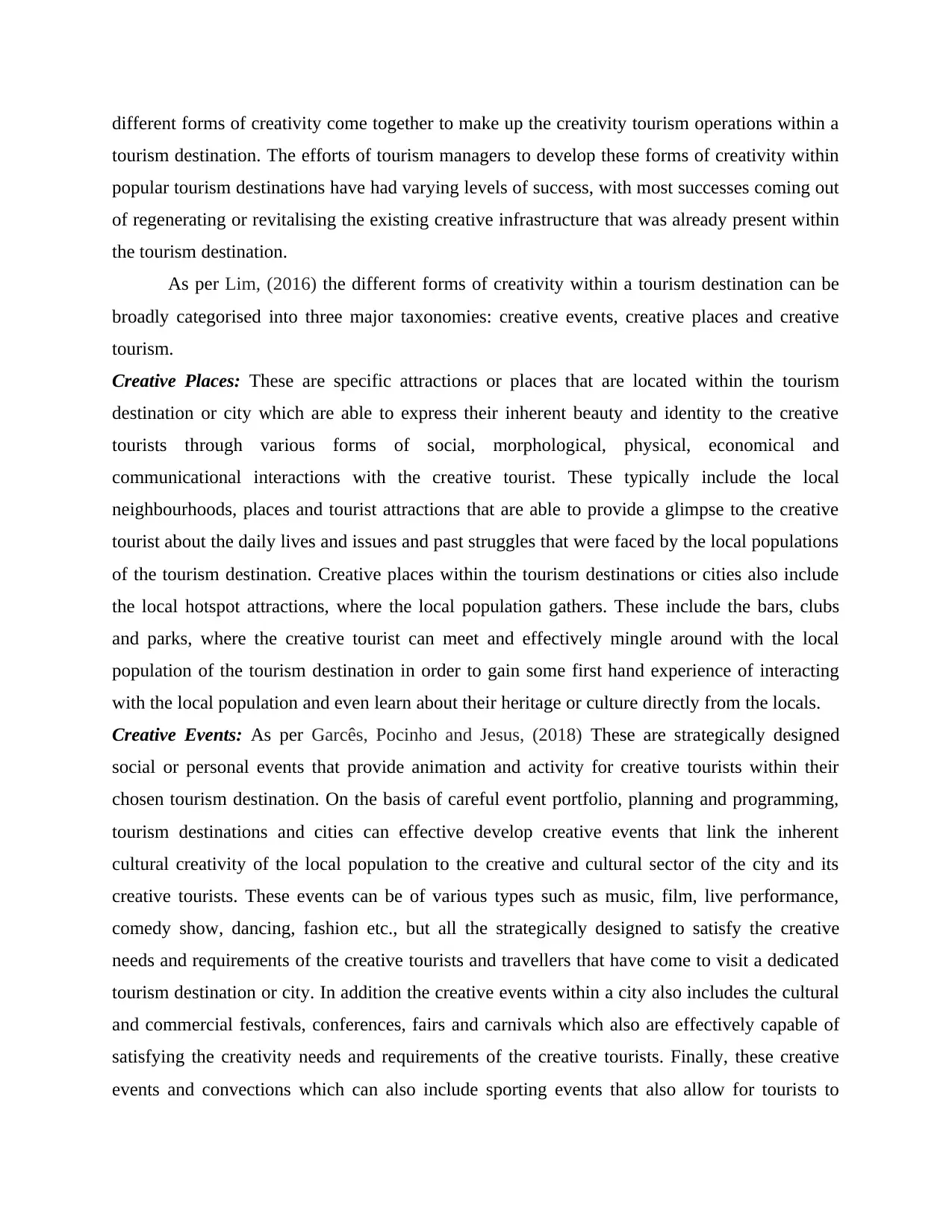
different forms of creativity come together to make up the creativity tourism operations within a
tourism destination. The efforts of tourism managers to develop these forms of creativity within
popular tourism destinations have had varying levels of success, with most successes coming out
of regenerating or revitalising the existing creative infrastructure that was already present within
the tourism destination.
As per Lim, (2016) the different forms of creativity within a tourism destination can be
broadly categorised into three major taxonomies: creative events, creative places and creative
tourism.
Creative Places: These are specific attractions or places that are located within the tourism
destination or city which are able to express their inherent beauty and identity to the creative
tourists through various forms of social, morphological, physical, economical and
communicational interactions with the creative tourist. These typically include the local
neighbourhoods, places and tourist attractions that are able to provide a glimpse to the creative
tourist about the daily lives and issues and past struggles that were faced by the local populations
of the tourism destination. Creative places within the tourism destinations or cities also include
the local hotspot attractions, where the local population gathers. These include the bars, clubs
and parks, where the creative tourist can meet and effectively mingle around with the local
population of the tourism destination in order to gain some first hand experience of interacting
with the local population and even learn about their heritage or culture directly from the locals.
Creative Events: As per Garcês, Pocinho and Jesus, (2018) These are strategically designed
social or personal events that provide animation and activity for creative tourists within their
chosen tourism destination. On the basis of careful event portfolio, planning and programming,
tourism destinations and cities can effective develop creative events that link the inherent
cultural creativity of the local population to the creative and cultural sector of the city and its
creative tourists. These events can be of various types such as music, film, live performance,
comedy show, dancing, fashion etc., but all the strategically designed to satisfy the creative
needs and requirements of the creative tourists and travellers that have come to visit a dedicated
tourism destination or city. In addition the creative events within a city also includes the cultural
and commercial festivals, conferences, fairs and carnivals which also are effectively capable of
satisfying the creativity needs and requirements of the creative tourists. Finally, these creative
events and convections which can also include sporting events that also allow for tourists to
tourism destination. The efforts of tourism managers to develop these forms of creativity within
popular tourism destinations have had varying levels of success, with most successes coming out
of regenerating or revitalising the existing creative infrastructure that was already present within
the tourism destination.
As per Lim, (2016) the different forms of creativity within a tourism destination can be
broadly categorised into three major taxonomies: creative events, creative places and creative
tourism.
Creative Places: These are specific attractions or places that are located within the tourism
destination or city which are able to express their inherent beauty and identity to the creative
tourists through various forms of social, morphological, physical, economical and
communicational interactions with the creative tourist. These typically include the local
neighbourhoods, places and tourist attractions that are able to provide a glimpse to the creative
tourist about the daily lives and issues and past struggles that were faced by the local populations
of the tourism destination. Creative places within the tourism destinations or cities also include
the local hotspot attractions, where the local population gathers. These include the bars, clubs
and parks, where the creative tourist can meet and effectively mingle around with the local
population of the tourism destination in order to gain some first hand experience of interacting
with the local population and even learn about their heritage or culture directly from the locals.
Creative Events: As per Garcês, Pocinho and Jesus, (2018) These are strategically designed
social or personal events that provide animation and activity for creative tourists within their
chosen tourism destination. On the basis of careful event portfolio, planning and programming,
tourism destinations and cities can effective develop creative events that link the inherent
cultural creativity of the local population to the creative and cultural sector of the city and its
creative tourists. These events can be of various types such as music, film, live performance,
comedy show, dancing, fashion etc., but all the strategically designed to satisfy the creative
needs and requirements of the creative tourists and travellers that have come to visit a dedicated
tourism destination or city. In addition the creative events within a city also includes the cultural
and commercial festivals, conferences, fairs and carnivals which also are effectively capable of
satisfying the creativity needs and requirements of the creative tourists. Finally, these creative
events and convections which can also include sporting events that also allow for tourists to
Paraphrase This Document
Need a fresh take? Get an instant paraphrase of this document with our AI Paraphraser
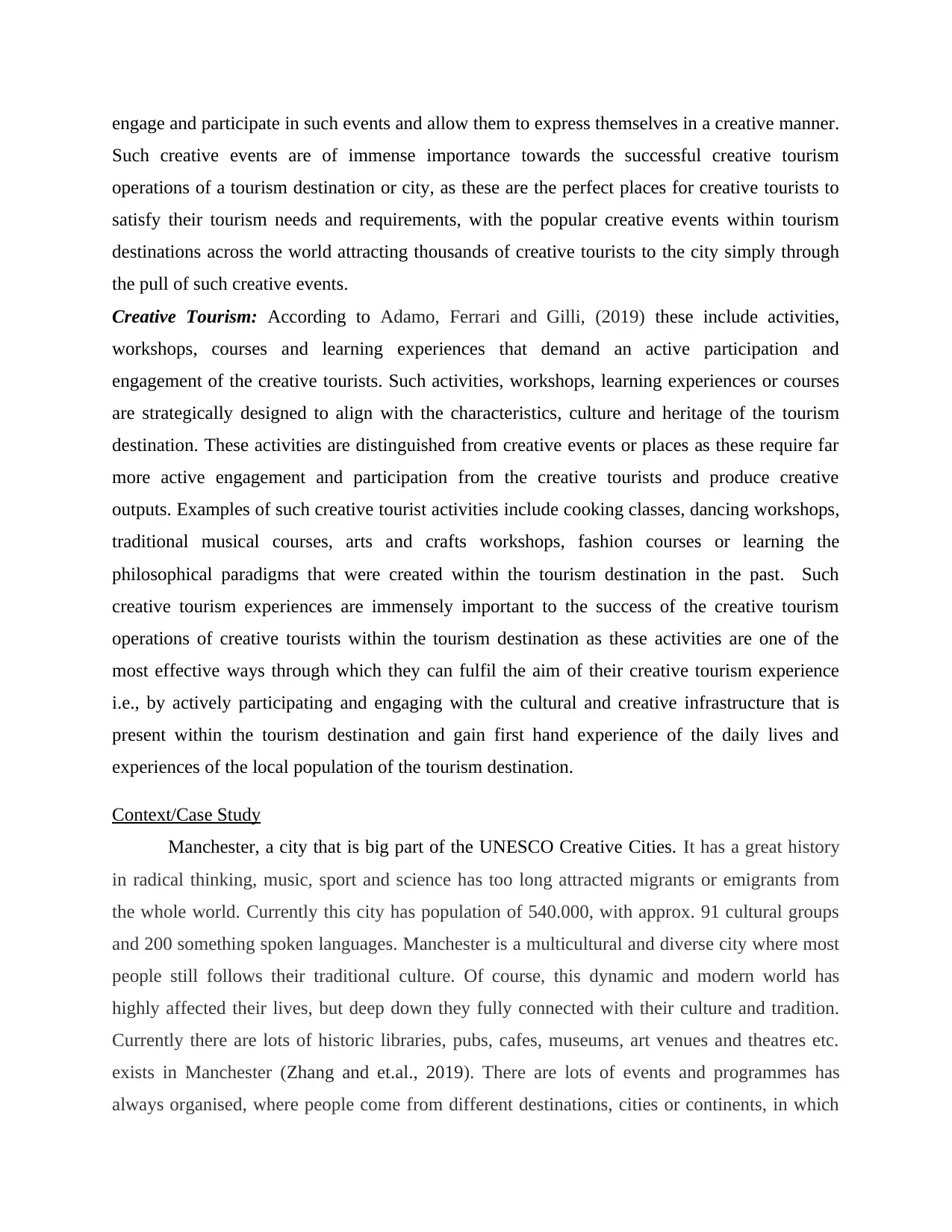
engage and participate in such events and allow them to express themselves in a creative manner.
Such creative events are of immense importance towards the successful creative tourism
operations of a tourism destination or city, as these are the perfect places for creative tourists to
satisfy their tourism needs and requirements, with the popular creative events within tourism
destinations across the world attracting thousands of creative tourists to the city simply through
the pull of such creative events.
Creative Tourism: According to Adamo, Ferrari and Gilli, (2019) these include activities,
workshops, courses and learning experiences that demand an active participation and
engagement of the creative tourists. Such activities, workshops, learning experiences or courses
are strategically designed to align with the characteristics, culture and heritage of the tourism
destination. These activities are distinguished from creative events or places as these require far
more active engagement and participation from the creative tourists and produce creative
outputs. Examples of such creative tourist activities include cooking classes, dancing workshops,
traditional musical courses, arts and crafts workshops, fashion courses or learning the
philosophical paradigms that were created within the tourism destination in the past. Such
creative tourism experiences are immensely important to the success of the creative tourism
operations of creative tourists within the tourism destination as these activities are one of the
most effective ways through which they can fulfil the aim of their creative tourism experience
i.e., by actively participating and engaging with the cultural and creative infrastructure that is
present within the tourism destination and gain first hand experience of the daily lives and
experiences of the local population of the tourism destination.
Context/Case Study
Manchester, a city that is big part of the UNESCO Creative Cities. It has a great history
in radical thinking, music, sport and science has too long attracted migrants or emigrants from
the whole world. Currently this city has population of 540.000, with approx. 91 cultural groups
and 200 something spoken languages. Manchester is a multicultural and diverse city where most
people still follows their traditional culture. Of course, this dynamic and modern world has
highly affected their lives, but deep down they fully connected with their culture and tradition.
Currently there are lots of historic libraries, pubs, cafes, museums, art venues and theatres etc.
exists in Manchester (Zhang and et.al., 2019). There are lots of events and programmes has
always organised, where people come from different destinations, cities or continents, in which
Such creative events are of immense importance towards the successful creative tourism
operations of a tourism destination or city, as these are the perfect places for creative tourists to
satisfy their tourism needs and requirements, with the popular creative events within tourism
destinations across the world attracting thousands of creative tourists to the city simply through
the pull of such creative events.
Creative Tourism: According to Adamo, Ferrari and Gilli, (2019) these include activities,
workshops, courses and learning experiences that demand an active participation and
engagement of the creative tourists. Such activities, workshops, learning experiences or courses
are strategically designed to align with the characteristics, culture and heritage of the tourism
destination. These activities are distinguished from creative events or places as these require far
more active engagement and participation from the creative tourists and produce creative
outputs. Examples of such creative tourist activities include cooking classes, dancing workshops,
traditional musical courses, arts and crafts workshops, fashion courses or learning the
philosophical paradigms that were created within the tourism destination in the past. Such
creative tourism experiences are immensely important to the success of the creative tourism
operations of creative tourists within the tourism destination as these activities are one of the
most effective ways through which they can fulfil the aim of their creative tourism experience
i.e., by actively participating and engaging with the cultural and creative infrastructure that is
present within the tourism destination and gain first hand experience of the daily lives and
experiences of the local population of the tourism destination.
Context/Case Study
Manchester, a city that is big part of the UNESCO Creative Cities. It has a great history
in radical thinking, music, sport and science has too long attracted migrants or emigrants from
the whole world. Currently this city has population of 540.000, with approx. 91 cultural groups
and 200 something spoken languages. Manchester is a multicultural and diverse city where most
people still follows their traditional culture. Of course, this dynamic and modern world has
highly affected their lives, but deep down they fully connected with their culture and tradition.
Currently there are lots of historic libraries, pubs, cafes, museums, art venues and theatres etc.
exists in Manchester (Zhang and et.al., 2019). There are lots of events and programmes has
always organised, where people come from different destinations, cities or continents, in which
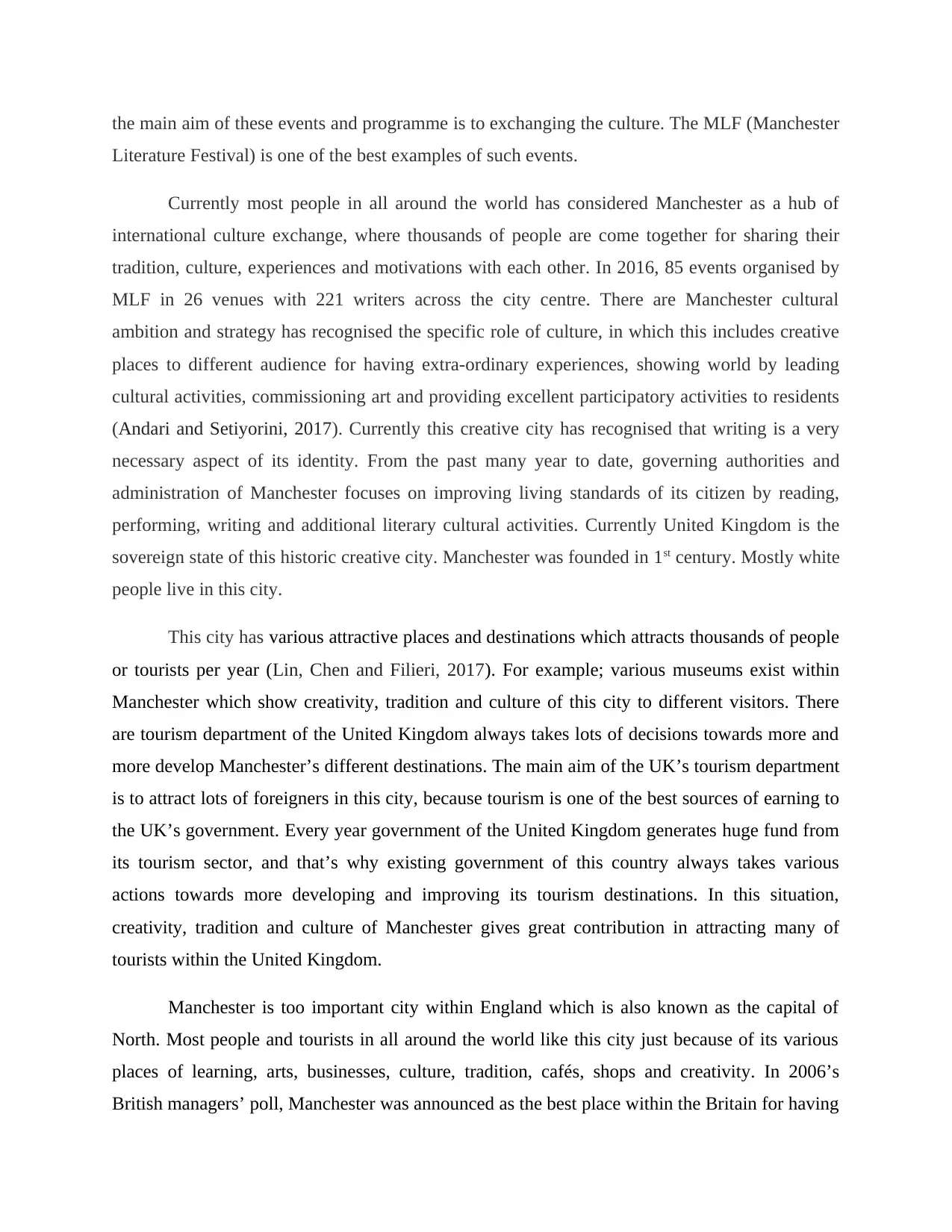
the main aim of these events and programme is to exchanging the culture. The MLF (Manchester
Literature Festival) is one of the best examples of such events.
Currently most people in all around the world has considered Manchester as a hub of
international culture exchange, where thousands of people are come together for sharing their
tradition, culture, experiences and motivations with each other. In 2016, 85 events organised by
MLF in 26 venues with 221 writers across the city centre. There are Manchester cultural
ambition and strategy has recognised the specific role of culture, in which this includes creative
places to different audience for having extra-ordinary experiences, showing world by leading
cultural activities, commissioning art and providing excellent participatory activities to residents
(Andari and Setiyorini, 2017). Currently this creative city has recognised that writing is a very
necessary aspect of its identity. From the past many year to date, governing authorities and
administration of Manchester focuses on improving living standards of its citizen by reading,
performing, writing and additional literary cultural activities. Currently United Kingdom is the
sovereign state of this historic creative city. Manchester was founded in 1st century. Mostly white
people live in this city.
This city has various attractive places and destinations which attracts thousands of people
or tourists per year (Lin, Chen and Filieri, 2017). For example; various museums exist within
Manchester which show creativity, tradition and culture of this city to different visitors. There
are tourism department of the United Kingdom always takes lots of decisions towards more and
more develop Manchester’s different destinations. The main aim of the UK’s tourism department
is to attract lots of foreigners in this city, because tourism is one of the best sources of earning to
the UK’s government. Every year government of the United Kingdom generates huge fund from
its tourism sector, and that’s why existing government of this country always takes various
actions towards more developing and improving its tourism destinations. In this situation,
creativity, tradition and culture of Manchester gives great contribution in attracting many of
tourists within the United Kingdom.
Manchester is too important city within England which is also known as the capital of
North. Most people and tourists in all around the world like this city just because of its various
places of learning, arts, businesses, culture, tradition, cafés, shops and creativity. In 2006’s
British managers’ poll, Manchester was announced as the best place within the Britain for having
Literature Festival) is one of the best examples of such events.
Currently most people in all around the world has considered Manchester as a hub of
international culture exchange, where thousands of people are come together for sharing their
tradition, culture, experiences and motivations with each other. In 2016, 85 events organised by
MLF in 26 venues with 221 writers across the city centre. There are Manchester cultural
ambition and strategy has recognised the specific role of culture, in which this includes creative
places to different audience for having extra-ordinary experiences, showing world by leading
cultural activities, commissioning art and providing excellent participatory activities to residents
(Andari and Setiyorini, 2017). Currently this creative city has recognised that writing is a very
necessary aspect of its identity. From the past many year to date, governing authorities and
administration of Manchester focuses on improving living standards of its citizen by reading,
performing, writing and additional literary cultural activities. Currently United Kingdom is the
sovereign state of this historic creative city. Manchester was founded in 1st century. Mostly white
people live in this city.
This city has various attractive places and destinations which attracts thousands of people
or tourists per year (Lin, Chen and Filieri, 2017). For example; various museums exist within
Manchester which show creativity, tradition and culture of this city to different visitors. There
are tourism department of the United Kingdom always takes lots of decisions towards more and
more develop Manchester’s different destinations. The main aim of the UK’s tourism department
is to attract lots of foreigners in this city, because tourism is one of the best sources of earning to
the UK’s government. Every year government of the United Kingdom generates huge fund from
its tourism sector, and that’s why existing government of this country always takes various
actions towards more developing and improving its tourism destinations. In this situation,
creativity, tradition and culture of Manchester gives great contribution in attracting many of
tourists within the United Kingdom.
Manchester is too important city within England which is also known as the capital of
North. Most people and tourists in all around the world like this city just because of its various
places of learning, arts, businesses, culture, tradition, cafés, shops and creativity. In 2006’s
British managers’ poll, Manchester was announced as the best place within the Britain for having
⊘ This is a preview!⊘
Do you want full access?
Subscribe today to unlock all pages.

Trusted by 1+ million students worldwide

a venture (Vada Prentice and Hsiao, 2019). From the last many year to date, Manchester is one
of the fast-growing cities in the United Kingdom. In 2002, this city was hosted Commonwealth
Games, so that many people across the world was known about this city on that time. Currently
many people within all around the world has known this city because of its two popular football
team as well, called; Manchester City and Manchester United. In the time period of industrial
revolution, this is the only across the United Kingdom which was industrialised itself. On that
time, existing business and venture owners was produced some innovative and creative products
and services in each sector, like; clothes, fabric, groceries, automobile etc.
In the 19th century, Manchester had the nickname called Cottonopolis, because on that
time this city had lots of cotton mills. On the other side, the centre of Manchester is very
important just because of its an effective network of different creative canals built during in the
19th-century (Miettinen and et.al., 2019). In the 1980s, the revival of Manchester’s importance
started. Basically, this was partly led through a vibrant music’s one scene whose spirit was
known as 'Madchester', in which it was led through bands such as Joy Division and The Happy
Mondays. This city is also famous of its very old university called “The University of
Manchester”, it is the biggest university within the United Kingdom. Reason is, this university
has over 30,000 number of students. Then, Manchester also has the UK's fourth largest
university, the Manchester Metropolitan University.
In this dynamic and modern world, this city is able to give great historic experience to
different tourists and visitors. Day by day number of visitors are increasing in Manchester.
Basically, people like to explore this city which has full of tradition, culture and creativity.
Currently thousands of people are sharing their very positive experience on different social
media platform about this historic city Manchester, in which this factor can make more popular
to this city in across the world.
Creative Tourist Trail
Creative tourist trail plays an excellent role in the development of a destination or tourist
place. Currently administration and local governing bodies within Manchester completely
focuses on more and more developing this city to attract many new visitors from across the
world. Of course, administration of Manchester is continuously conducting lots of activities to
of the fast-growing cities in the United Kingdom. In 2002, this city was hosted Commonwealth
Games, so that many people across the world was known about this city on that time. Currently
many people within all around the world has known this city because of its two popular football
team as well, called; Manchester City and Manchester United. In the time period of industrial
revolution, this is the only across the United Kingdom which was industrialised itself. On that
time, existing business and venture owners was produced some innovative and creative products
and services in each sector, like; clothes, fabric, groceries, automobile etc.
In the 19th century, Manchester had the nickname called Cottonopolis, because on that
time this city had lots of cotton mills. On the other side, the centre of Manchester is very
important just because of its an effective network of different creative canals built during in the
19th-century (Miettinen and et.al., 2019). In the 1980s, the revival of Manchester’s importance
started. Basically, this was partly led through a vibrant music’s one scene whose spirit was
known as 'Madchester', in which it was led through bands such as Joy Division and The Happy
Mondays. This city is also famous of its very old university called “The University of
Manchester”, it is the biggest university within the United Kingdom. Reason is, this university
has over 30,000 number of students. Then, Manchester also has the UK's fourth largest
university, the Manchester Metropolitan University.
In this dynamic and modern world, this city is able to give great historic experience to
different tourists and visitors. Day by day number of visitors are increasing in Manchester.
Basically, people like to explore this city which has full of tradition, culture and creativity.
Currently thousands of people are sharing their very positive experience on different social
media platform about this historic city Manchester, in which this factor can make more popular
to this city in across the world.
Creative Tourist Trail
Creative tourist trail plays an excellent role in the development of a destination or tourist
place. Currently administration and local governing bodies within Manchester completely
focuses on more and more developing this city to attract many new visitors from across the
world. Of course, administration of Manchester is continuously conducting lots of activities to
Paraphrase This Document
Need a fresh take? Get an instant paraphrase of this document with our AI Paraphraser
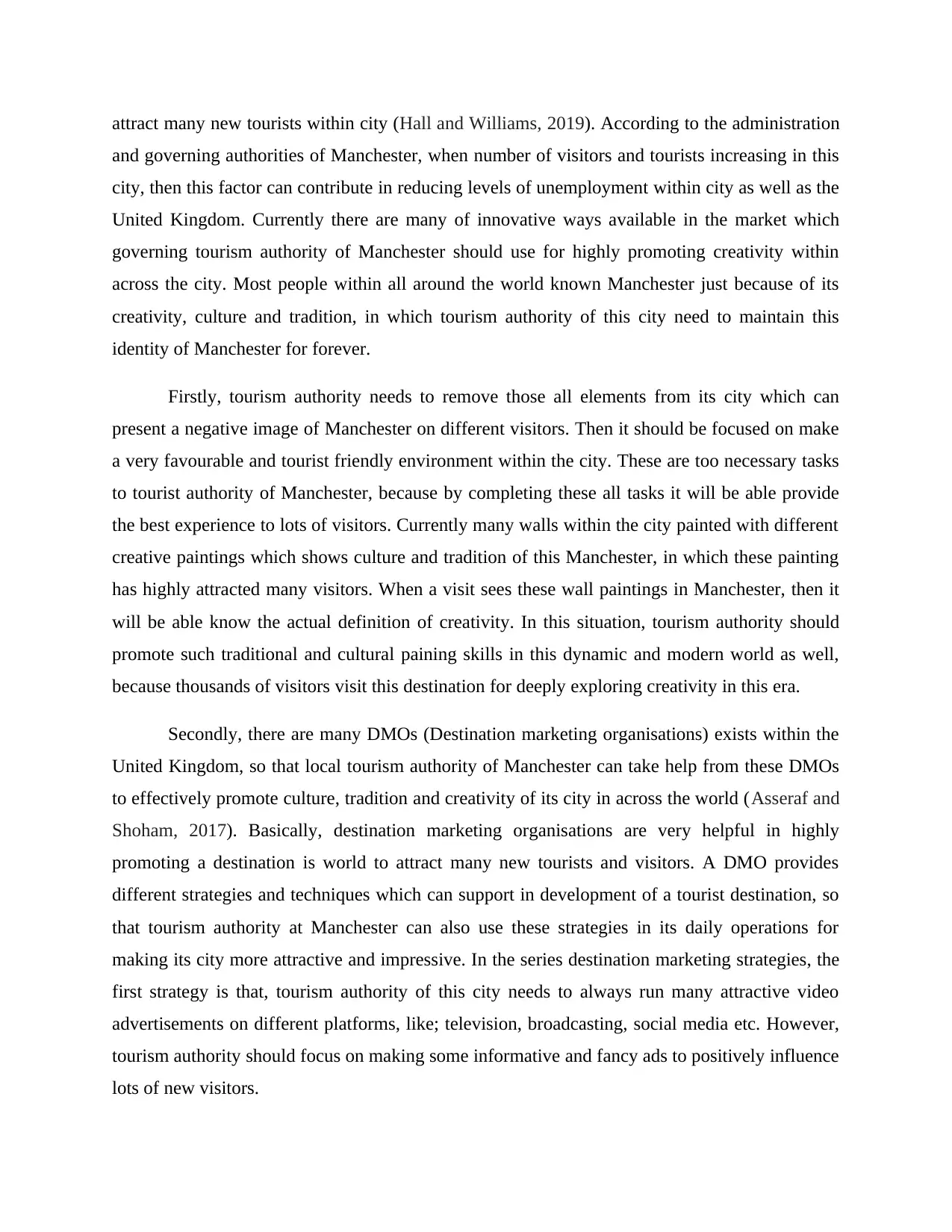
attract many new tourists within city (Hall and Williams, 2019). According to the administration
and governing authorities of Manchester, when number of visitors and tourists increasing in this
city, then this factor can contribute in reducing levels of unemployment within city as well as the
United Kingdom. Currently there are many of innovative ways available in the market which
governing tourism authority of Manchester should use for highly promoting creativity within
across the city. Most people within all around the world known Manchester just because of its
creativity, culture and tradition, in which tourism authority of this city need to maintain this
identity of Manchester for forever.
Firstly, tourism authority needs to remove those all elements from its city which can
present a negative image of Manchester on different visitors. Then it should be focused on make
a very favourable and tourist friendly environment within the city. These are too necessary tasks
to tourist authority of Manchester, because by completing these all tasks it will be able provide
the best experience to lots of visitors. Currently many walls within the city painted with different
creative paintings which shows culture and tradition of this Manchester, in which these painting
has highly attracted many visitors. When a visit sees these wall paintings in Manchester, then it
will be able know the actual definition of creativity. In this situation, tourism authority should
promote such traditional and cultural paining skills in this dynamic and modern world as well,
because thousands of visitors visit this destination for deeply exploring creativity in this era.
Secondly, there are many DMOs (Destination marketing organisations) exists within the
United Kingdom, so that local tourism authority of Manchester can take help from these DMOs
to effectively promote culture, tradition and creativity of its city in across the world (Asseraf and
Shoham, 2017). Basically, destination marketing organisations are very helpful in highly
promoting a destination is world to attract many new tourists and visitors. A DMO provides
different strategies and techniques which can support in development of a tourist destination, so
that tourism authority at Manchester can also use these strategies in its daily operations for
making its city more attractive and impressive. In the series destination marketing strategies, the
first strategy is that, tourism authority of this city needs to always run many attractive video
advertisements on different platforms, like; television, broadcasting, social media etc. However,
tourism authority should focus on making some informative and fancy ads to positively influence
lots of new visitors.
and governing authorities of Manchester, when number of visitors and tourists increasing in this
city, then this factor can contribute in reducing levels of unemployment within city as well as the
United Kingdom. Currently there are many of innovative ways available in the market which
governing tourism authority of Manchester should use for highly promoting creativity within
across the city. Most people within all around the world known Manchester just because of its
creativity, culture and tradition, in which tourism authority of this city need to maintain this
identity of Manchester for forever.
Firstly, tourism authority needs to remove those all elements from its city which can
present a negative image of Manchester on different visitors. Then it should be focused on make
a very favourable and tourist friendly environment within the city. These are too necessary tasks
to tourist authority of Manchester, because by completing these all tasks it will be able provide
the best experience to lots of visitors. Currently many walls within the city painted with different
creative paintings which shows culture and tradition of this Manchester, in which these painting
has highly attracted many visitors. When a visit sees these wall paintings in Manchester, then it
will be able know the actual definition of creativity. In this situation, tourism authority should
promote such traditional and cultural paining skills in this dynamic and modern world as well,
because thousands of visitors visit this destination for deeply exploring creativity in this era.
Secondly, there are many DMOs (Destination marketing organisations) exists within the
United Kingdom, so that local tourism authority of Manchester can take help from these DMOs
to effectively promote culture, tradition and creativity of its city in across the world (Asseraf and
Shoham, 2017). Basically, destination marketing organisations are very helpful in highly
promoting a destination is world to attract many new tourists and visitors. A DMO provides
different strategies and techniques which can support in development of a tourist destination, so
that tourism authority at Manchester can also use these strategies in its daily operations for
making its city more attractive and impressive. In the series destination marketing strategies, the
first strategy is that, tourism authority of this city needs to always run many attractive video
advertisements on different platforms, like; television, broadcasting, social media etc. However,
tourism authority should focus on making some informative and fancy ads to positively influence
lots of new visitors.
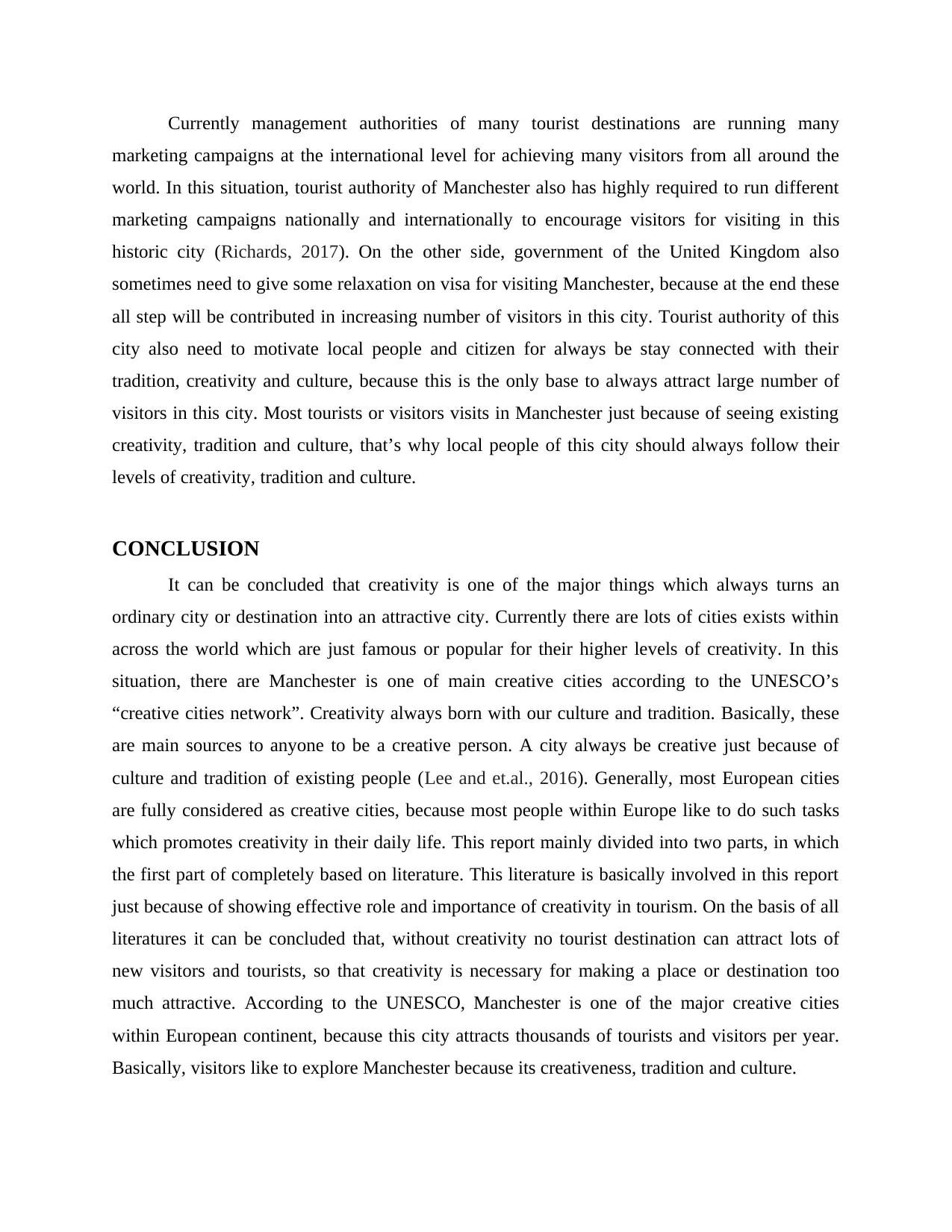
Currently management authorities of many tourist destinations are running many
marketing campaigns at the international level for achieving many visitors from all around the
world. In this situation, tourist authority of Manchester also has highly required to run different
marketing campaigns nationally and internationally to encourage visitors for visiting in this
historic city (Richards, 2017). On the other side, government of the United Kingdom also
sometimes need to give some relaxation on visa for visiting Manchester, because at the end these
all step will be contributed in increasing number of visitors in this city. Tourist authority of this
city also need to motivate local people and citizen for always be stay connected with their
tradition, creativity and culture, because this is the only base to always attract large number of
visitors in this city. Most tourists or visitors visits in Manchester just because of seeing existing
creativity, tradition and culture, that’s why local people of this city should always follow their
levels of creativity, tradition and culture.
CONCLUSION
It can be concluded that creativity is one of the major things which always turns an
ordinary city or destination into an attractive city. Currently there are lots of cities exists within
across the world which are just famous or popular for their higher levels of creativity. In this
situation, there are Manchester is one of main creative cities according to the UNESCO’s
“creative cities network”. Creativity always born with our culture and tradition. Basically, these
are main sources to anyone to be a creative person. A city always be creative just because of
culture and tradition of existing people (Lee and et.al., 2016). Generally, most European cities
are fully considered as creative cities, because most people within Europe like to do such tasks
which promotes creativity in their daily life. This report mainly divided into two parts, in which
the first part of completely based on literature. This literature is basically involved in this report
just because of showing effective role and importance of creativity in tourism. On the basis of all
literatures it can be concluded that, without creativity no tourist destination can attract lots of
new visitors and tourists, so that creativity is necessary for making a place or destination too
much attractive. According to the UNESCO, Manchester is one of the major creative cities
within European continent, because this city attracts thousands of tourists and visitors per year.
Basically, visitors like to explore Manchester because its creativeness, tradition and culture.
marketing campaigns at the international level for achieving many visitors from all around the
world. In this situation, tourist authority of Manchester also has highly required to run different
marketing campaigns nationally and internationally to encourage visitors for visiting in this
historic city (Richards, 2017). On the other side, government of the United Kingdom also
sometimes need to give some relaxation on visa for visiting Manchester, because at the end these
all step will be contributed in increasing number of visitors in this city. Tourist authority of this
city also need to motivate local people and citizen for always be stay connected with their
tradition, creativity and culture, because this is the only base to always attract large number of
visitors in this city. Most tourists or visitors visits in Manchester just because of seeing existing
creativity, tradition and culture, that’s why local people of this city should always follow their
levels of creativity, tradition and culture.
CONCLUSION
It can be concluded that creativity is one of the major things which always turns an
ordinary city or destination into an attractive city. Currently there are lots of cities exists within
across the world which are just famous or popular for their higher levels of creativity. In this
situation, there are Manchester is one of main creative cities according to the UNESCO’s
“creative cities network”. Creativity always born with our culture and tradition. Basically, these
are main sources to anyone to be a creative person. A city always be creative just because of
culture and tradition of existing people (Lee and et.al., 2016). Generally, most European cities
are fully considered as creative cities, because most people within Europe like to do such tasks
which promotes creativity in their daily life. This report mainly divided into two parts, in which
the first part of completely based on literature. This literature is basically involved in this report
just because of showing effective role and importance of creativity in tourism. On the basis of all
literatures it can be concluded that, without creativity no tourist destination can attract lots of
new visitors and tourists, so that creativity is necessary for making a place or destination too
much attractive. According to the UNESCO, Manchester is one of the major creative cities
within European continent, because this city attracts thousands of tourists and visitors per year.
Basically, visitors like to explore Manchester because its creativeness, tradition and culture.
⊘ This is a preview!⊘
Do you want full access?
Subscribe today to unlock all pages.

Trusted by 1+ million students worldwide
1 out of 15
Related Documents
Your All-in-One AI-Powered Toolkit for Academic Success.
+13062052269
info@desklib.com
Available 24*7 on WhatsApp / Email
![[object Object]](/_next/static/media/star-bottom.7253800d.svg)
Unlock your academic potential
Copyright © 2020–2025 A2Z Services. All Rights Reserved. Developed and managed by ZUCOL.




